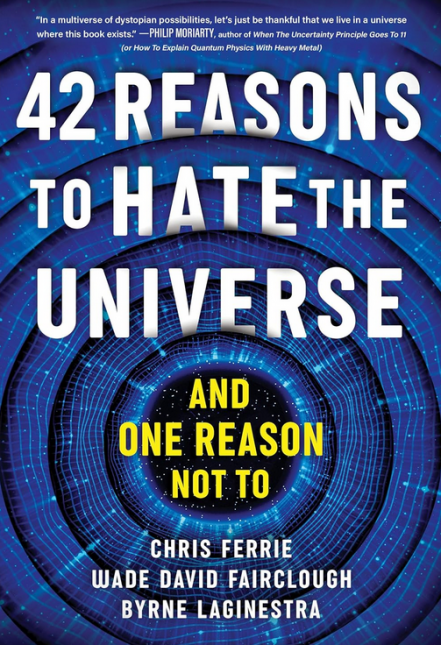42 Reasons to Hate the Universe: (And One Reason Not to)
- By Chris Ferrie, Wade David Fairclough, and Byrne Laginestra
- Sourcebooks
- 304 pp.
- Reviewed by Randy Cepuch
- February 2, 2024
We’re all doomed, so why not laugh?

The hilarious 42 Reasons to Hate the Universe spells out in ticklish detail many of the ways the cosmic deck is stacked against us. It’s written by three snarky Australian educators whose classes are surely popular because students never know when an F-bomb might drop. But just as imaginative flight-safety briefings can get the attention of even the most jaded airline passengers, making science funny often makes it clearer and more compelling.
Aussies, of course, are well-acquainted with earthly perils. (In his brilliant Down Under travelogue, In a Sunburned Country, Bill Bryson warns that Australia “has more things that will kill you than anywhere else.”) So it’s not surprising when the authors ask, “What sort of universe creates a planet swarming with life-forms and then decides to put venomous snakes everywhere?”
There are many answers to that question, and the 42 in this book cover a lot of ground, which makes sense, considering the authors are implicating the entire universe. The reasons for all the peril are grouped into seven sections: “The Universe Is Out to Get You,” “Technology Is Not Going to Save You,” “You Are a Frail Sack of Meat Anyway,” “This Planet Isn’t That Great,” “But There Is Nowhere Else to Go,” “The Universe Is Going to Win in the End,” and “So Let’s Go Crazy.” Read them in whatever order you want, and you’ll still learn and laugh.
If you’re fascinated by, say, wildfires, the authors explain:
“The Australian bushland actually needs to occasionally die to survive, which sounds like an argument an embarrassed vampire might try to give you before dinner.”
Curious about the risks of nuclear energy? They’ll assure you that nuke-plant workers in general have lower exposure levels than most people:
“Unless, of course, the power plant you work at happens to be on an island approximately three miles long, as well as about three miles from the Harrisburg airport and also three miles from Middletown, Pennsylvania. The name escapes us right now.”
Autoimmune diseases, which affect about 5 percent of the world’s population? They’ll point out that most sufferers are over age 40, “clearly showing the Universe is ageist. They also disproportionately affect females, showing the Universe is also sexist. And certain autoimmune disorders present in people of color more frequently than people of European descent, showing the Universe is racist as well. Thankfully it doesn’t have its own podcast.”
Solar flares have you worried? Sure, a bad one could wreak havoc around the world, taking out the internet, “but the effectiveness of the customer service department of your provider would remain about the same.” And if GPS is affected, and you’re aboard a plane headed for New Zealand? “That potentially mutagenic blast could very quickly turn your transatlantic flight into the second worst Carnival Cruise of your life.” (Er, transpacific. Good thing these guys don’t teach geography.)
Helpfully, scientific measurements are translated into terms that are easy for average readers to understand. Here’s how PSI (pounds per square inch) is described, for example: “A basketball is 8 PSI, while your blood pressure is about 2 PSI — higher if you’ve invited indignant relatives over for dinner.”
Then again, unless you’re familiar with meerkats, being prompted to imagine a stack of them to illustrate changes in tectonic-plate heights may be more amusing than helpful. Still, the image gets the point across:
“Earthquakes are just another example of how the gradual, almost peaceful movements of the Universe have been shoved aside in favor of violence with no warning, no consideration of guilt, and little chance of escape for anyone but the top meerkat.”
Creative imagery also helps readers visualize water molecules. We’re told to think of Mickey Mouse’s ears as hydrogen atoms and the oxygen atom as his head, and then we’re advised, “But please don’t hold the picture for too long, or else Disney may sue.”
Each of the reasons for despair underscores in one way or another that the probability the sun will rise tomorrow is very, very high — but not a sure thing. (By the way, the authors’ “One Reason” for hope is a pretty good one.) Just don’t lose too much sleep over our galaxy’s demise; there’s no need:
“The edge of the growing vaccuum decay is a firewall of intense energy that essentially deletes everything in its path. But don’t worry, it will be traveling at the speed of light, and so it’s impossible to see it com...”
Randy Cepuch is a member of the Independent’s board of directors and the author of A Weekend with Warren Buffett and Other Shareholder Meeting Adventures. Reading this book reminded him that Buffett’s right-hand man, Charlie Munger, who was just 34 days shy of 100 years old when he passed away in November, used to say, “The only thing I want to know is where I’m going to die so I never go there.”
_80_120.png)
